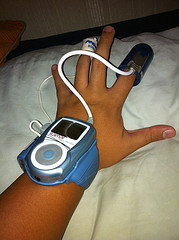
flickr.com/besighyawn
Let’s say you have a snoring problem, and you wake most mornings to your partner’s cold shoulder. Or, your partner snores and you can no longer stand one more thunderous night. It’s a big problem, but treatment alternatives are available.
Sooner or later in every snorer’s life, there comes a time when the condition stops being an annoying habit, and starts being a legitimate trouble. You, or your partner, can’t avoid the issue anymore. Something has to be done, but what? There are several options that can make a real difference.
Snore Balls
Many snorers do snore simply because of their sleep position. If you sleep while lying flat on your back, you’re more prone to snore. One easy solution is just to lie on your side, and a simple tennis ball can be simply the thing to keep you there. In the early 1900s, the “snore ball” was originally invented, although some advancement has been made since then. It’s a simple pouch, connected to the back of the pajamas, with balls placed inside. The premise is very simple: the snorer falls asleep on his or her side, but at some point during the night will invariably turn over onto his or her back. However, with the snore ball in place, the back-sleeping position is practically unbearable. The device normally wakes up the snorer long enough to turn back to the side position and drift once again into a deep, quiet sleep. Snore balls are accessible to buy, but you can easily make one yourself. Depending upon your personal size preference, you can choose something small like a golf ball or a few marbles or something bigger like a tennis or baseball. Sew the ball into a cloth pouch, or even a tennis sock, and connect it to the back of the pajamas using safety pins. Many people combat snoring using this non-evasive, inexpensive, and easy-to-do treatment.
Sleep Monitors
A sleep position monitor is a similar alternative way to fight snoring. Not unlike the snore ball, the sleep monitor warns the snorer when he or she tries to turn onto the back by emitting a loud beeping sound. The trouble with this device is that it also alerts the innocent partner. Those who opt to sleep with position monitor and sleeping ball do so in the hope that they will eventually become “accustomed” and will stop rolling on to their backs.
Nasal Strips
These easy-to-use, low cost options are available without a prescription at most drug stores. Nasal strips are intended to widen the nasal passages, open the air passageway to the throat, and increase airflow. The plastic adhesive strips are non-medicated, and stay stuck to the nose the whole night. Many athletes also choose to wear nasal strips while practicing, playing, and working out, claiming that they are able to breathe and perform more effectively.
Sleep better! Check out the world's Best MATTRESS TOPPER.
Throat Sprays
Some snorers have also tried throat sprays, with some accomplishment. The objective of the throat spray is to lubricate the back of the throat and lessen the vibrations that cause snoring. With overuse, however, the spray can actually irritate the throat and, in turn, encourage more snoring. Therefore, the instructions on the package must be followed very thoroughly.
Other, more expensive and invasive treatment alternatives are available, but try making these simple solutions your first steps in your efforts to fight snoring.
Which one of these is this the world's best foam mattress?
Candidate "A"
Candidate "B" -- you decide 🙂
Tagged with: combat snoring • snorer
Filed under: Snoring